Evaluation and Classification of Rural Multifunction at a Grid Scale: A Case Study of Miyun District, Beijing
Abstract
1. Introduction
2. Theoretical Framework
2.1. Rural Multifunction
2.2. Territorial Spatial Planning and PLE Spaces
3. Materials and Methods
3.1. Study Area
3.2. Data Sources and Methodology
3.2.1. Data Sources
3.2.2. Delimitation of Evaluation Units
3.2.3. Index System
3.2.4. Indicator Calculation Methods
3.2.5. Weight Method
3.2.6. Classification of Rural Multifunction
4. Results
4.1. Analysis of Index Calculation Results
4.2. Characteristics of Rural PLE Functions and Multifunction
4.3. Classification of Rural Multifunction
5. Discussion
6. Conclusions
- (1)
- The values of the production, living, ecological functions in Miyun District differed greatly. The average value and maximum value both showed that the functional intensity was ecological > living > production, indicating that the ecological function was dominant in this area. The value of multifunction was determined by the comprehensive action of the three single functions.
- (2)
- The overall spatial patterns of the production and living functions were characterized by the distribution of “high in the south and low in the north”, and areas with high values were distributed with moderate density around urban areas and the Miyun Reservoir with developed transportation, concentrated population and superior geographic conditions. In contrast to the spatial distribution characteristics of production and living functions, areas with strong ecological function were mainly distributed in the mountainous areas with high forest coverage in the northwest, northeast, east and south of Miyun District. Rural multifunction was strong in the mountainous areas and around urban areas.
- (3)
- Based on ISO clustering unsupervised classification, the rural multifunction of Miyun District was divided into four types: ecological conservation, employment and residence, recreation and potential development, with the area proportions of 44.22%, 17.92%, 20.73% and 17.13%, respectively. Each type of functional area showed a characteristic of aggregation. The differences in topography, geographical location and traffic conditions led to the differentiated formation and distribution of functional areas. In order to realize the sustainable development of each functional area, policies and development strategies should be formulated according to local conditions.
Author Contributions
Funding
Institutional Review Board Statement
Informed Consent Statement
Data Availability Statement
Acknowledgments
Conflicts of Interest
References
- Liu, Y.; Zhou, Y.; Li, Y. Rural regional system and rural revitalization strategy in China. Acta Geogr. Sin. 2019, 74, 2511–2528. [Google Scholar]
- Liu, Y. Research on the geography of rural revitalization in the new era. Geogr. Res. 2019, 38, 461–466. [Google Scholar]
- Liu, Y.; Li, Y. Revitalize the world’s countryside. Nature 2017, 548, 275–277. [Google Scholar] [CrossRef]
- Long, H. Land consolidation and rural spatial restructuring. Acta Geogr. Sin. 2013, 68, 1019–1028. [Google Scholar]
- Liu, Y. Introduction to land use and rural sustainability in China. Land Use Policy 2018, 74, 1–4. [Google Scholar] [CrossRef]
- Nelson, P.B. Rural restructuring in the American West: Land use, family and class discourses. J. Rural Stud. 2001, 17, 395–407. [Google Scholar] [CrossRef]
- Holmes, J. Impulses towards a multifunctional transition in rural Australia: Gaps in the research agenda. J. Rural Stud. 2006, 22, 142–160. [Google Scholar] [CrossRef]
- Wilson, O.J. Rural restructuring and agriculture-rural economy linkages: A New Zealand study. J. Rural Stud. 1995, 11, 417–431. [Google Scholar] [CrossRef]
- Lobley, M.; Potter, C. Agricultural change and restructuring: Recent evidence from a survey of agricultural households in England. J. Rural Stud. 2004, 20, 499–510. [Google Scholar] [CrossRef]
- Bañski, J.; Stola, W. Transformation of the spatial and functional structure of rural areas in Poland. J. Rural Stud. 2002, 3, 13. [Google Scholar]
- Long, H.; Tu, S.; Ge, D.; Li, T.; Liu, Y. The allocation and management of critical resources in rural China under restructuring: Problems and prospects. J. Rural Stud. 2016, 47, 392–412. [Google Scholar] [CrossRef]
- Li, Y.; Long, H.; Liu, Y. Spatio-temporal pattern of China’s rural development: A rurality index perspective. J. Rural Stud. 2015, 38, 12–26. [Google Scholar] [CrossRef]
- Long, H.; Tu, S. Rural restructuring: Theory, approach and research prospect. Acta Geogr. Sin. 2017, 72, 563–576. [Google Scholar]
- Huang, J.; Lin, H.; Qi, X. A literature review on optimization of spatial development pattern based on ecological-production-living space. Prog. Geogr. 2017, 36, 378–391. [Google Scholar]
- Li, G.; Fang, C. Quantitative function identification and analysis of urban ecological-production-living spaces. Acta Geogr. Sin. 2016, 71, 49–65. [Google Scholar]
- Dong, Z.; Zhang, J.; Si, A.; Tong, Z.; Na, L. Multidimensional analysis of the spatiotemporal variations in ecological, production and living spaces of Inner Mongolia and an identification of driving forces. Sustainability 2020, 12, 7964. [Google Scholar] [CrossRef]
- Wiggering, H.; Dalchow, C.; Glemnitz, M.; Helming, K.; Müller, K.; Schultz, A.; Stachow, U.; Zander, P. Indicators for multifunctional land use—Linking socio-economic requirements with landscape potentials. Ecol. Indic. 2006, 6, 238–249. [Google Scholar] [CrossRef]
- King, P.; Annandale, D.; Bailey, J. Integrated economic and environmental planning in Asia: A review of progress and proposals for policy reform. Prog. Plann. 2003, 59, 233–315. [Google Scholar] [CrossRef]
- Aizaki, H.; Sato, K.; Osari, H. Contingent valuation approach in measuring the multifunctionality of agriculture and rural areas in Japan. Paddy Water Environ. 2006, 4, 217–222. [Google Scholar] [CrossRef]
- Willemen, L.; Hein, L.; Van Mensvoort, M.E.F.; Verburg, P.H. Space for people, plants, and livestock? Quantifying interactions among multiple landscape functions in a Dutch rural region. Ecol. Indic. 2010, 10, 62–73. [Google Scholar] [CrossRef]
- Stola, W. An attempt at a functional classification on rural areas in Poland. A methodological approach. Geogr. Pol. 1984, 113–129. [Google Scholar]
- Andersen, P.S.; Vejre, H.; Dalgaard, T.; Brandt, J. An indicator-based method for quantifying farm multifunctionality. Ecol. Indic. 2013, 25, 166–179. [Google Scholar] [CrossRef]
- Huang, J.; Tichit, M.; Poulot, M.; Darly, S.; Li, S.; Petit, C.; Aubry, C. Comparative review of multifunctionality and ecosystem services in sustainable agriculture. J. Environ. Manag. 2015, 149, 138–147. [Google Scholar] [CrossRef]
- Huttunen, S. Revisiting agricultural modernisation: Interconnected farming practices driving rural development at the farm level. J. Rural Stud. 2019, 71, 36–45. [Google Scholar] [CrossRef]
- Távora, G.S.G.; Turetta, A.P.D. An approach to map landscape functions in Atlantic Forest—Brazil. Ecol. Indic. 2016, 71, 557–566. [Google Scholar] [CrossRef]
- Jeong, J.S.; García-Moruno, L.; Hernández-Blanco, J.; Sánchez-Ríos, A.; Ramírez-Gómez, Á. Identifying priority areas for rural housing development using the participatory multi-criteria and contingent valuation methods in Alange reservoir area, Central Extremadura (Spain). J. Rural Stud. 2017, 50, 117–128. [Google Scholar] [CrossRef]
- Wang, C.; Tang, N. Spatio-temporal characteristics and evolution of rural production-living-ecological space function coupling coordination in Chongqing Municipality. Geogr. Res. 2018, 37, 1100–1114. [Google Scholar]
- Qu, Y.; Wang, S.; Zhao, L.; Qu, Y.; Wang, S. Spatial pattern and regional regulation of rural territorial multi-functions in Shandong Province, China. Trans. Chin. Soc. Agric. Eng. 2020, 36, 222–232. [Google Scholar]
- Gu, X.; Xie, B.; Zhang, Z.; Guo, H.D. Rural multifunction in Shanghai suburbs: Evaluation and spatial characteristics based on villages. Habitat Int. 2019, 92, 102041. [Google Scholar] [CrossRef]
- Yang, Y.; Bao, W.; Liu, Y. Coupling coordination analysis of rural production-living-ecological space in the Beijing-Tianjin-Hebei region. Ecol. Indic. 2020, 117, 106512. [Google Scholar] [CrossRef]
- Gu, X.; Tao, S.; Lu, F.; Zhou, X. Multi-functional evaluation of metropolitan suburbs and its spatial difference: A case study of 89 towns in Shanghai. J. Nat. Res. 2019, 34, 2281–2290. [Google Scholar]
- Wilson, G.A. The spatiality of multifunctional agriculture: A human geography perspective. Geoforum 2009, 40, 269–280. [Google Scholar] [CrossRef]
- Liu, Y.; Liu, Y.; Guo, L. Connotations of rural regional multifunction and its policy implications in China. Hum. Geogr. 2011, 26, 103–106. [Google Scholar]
- Jiang, G.; Wang, M.; Qu, Y.; Zhou, D.; Ma, W. Towards cultivated land multifunction assessment in China: Applying the “influencing factors-functions-products-demands” integrated framework. Land Use Policy 2020, 99, 104982. [Google Scholar] [CrossRef]
- Yang, B.; Chen, P.; Dong, K.; Sun, J. Formation of the national territory development planning system under the background of ecological civilization. Urban Plan. Forum 2019, 16–23. [Google Scholar] [CrossRef]
- Yan, J.; Chen, H.; Xia, F. Cognition, direction and path of future spatial planning based on the background of multiple planning integration. China Land Sci. 2017, 31, 21–27. [Google Scholar]
- Liu, Y.; Tang, L.; Pan, Y. Multifunctional characteristics and revitalization strategies of different types of rural development at village scale. Trans. Chin. Soc. Agric. Eng. 2019, 35, 9–17. [Google Scholar]
- Liu, Y.; Tang, L.; Ren, Y.; Xian, W. Evaluation of rural leisure functions based on multidimensional combination of characteristics in Miyun district of Beijing, China. Mt. Res. 2020, 38, 751–762. [Google Scholar]
- Meng, J.; Wang, Q.; Li, F.; Guo, L. Assessing multifunctional land use in the middle reach of the Heihe River basin based on spatial variances. Geogr. Res. 2019, 38, 369–382. [Google Scholar]
- Ma, X.; Li, X.; Hu, R.; Khuong, M.H. Delineation of “production-living-ecological” space for urban fringe based on rural multifunction evaluation. Prog. Geogr. 2019, 38, 1382–1392. [Google Scholar] [CrossRef]
- Fan, Y.; Jin, X.; Xiang, X.; Yang, X.; Liu, J.; Zhou, Y. Evaluation and spatial characteristics of arable land multifunction in southern Jiangsu. Resour. Sci. 2018, 40, 980–992. [Google Scholar]
- Yang, R.; Liu, Y.; Long, H.; Chen, C. Spatial-temporal characteristics of rural residential land use change and spatial directivity identification based on grid in the Bohai Rim in China. Geogr. Res. 2015, 34, 1077–1087. [Google Scholar]
- Li, X.; Liu, W.; Xie, Y.; Xu, X.; Dai, J. The delineation and empirical study of production-living-ecological space in village under the background of multiple planning integration. Econ. Geogr. 2019, 39, 146–152. [Google Scholar]
- Liu, Y.; Ren, Y.; Pan, Y.; Tang, L. Rural development pattern and zoning for rural revitalization strategy. Trans. Chin. Soc. Agric. Eng. 2019, 35, 281–289. [Google Scholar]
- Qu, Y.; Jiang, G.; Zhao, Q.; Ma, W.; Zhang, R.; Yang, Y. Geographic identification, spatial differentiation, and formation mechanism of multifunction of rural settlements: A case study of 804 typical villages in Shandong Province, China. J. Clean. Prod. 2017, 166, 1202–1215. [Google Scholar] [CrossRef]
- Zhang, H. Research on Spatial Layout Optimization of Hierarchical Medical Service Facilities Based on GIS in Xi’an City. Master’s Thesis, Northwest University, Xi’an, China, 2019. [Google Scholar]
- Guo, M. Resource Allocation and Spatial Layout Efficiency Evaluation of Basic Education in Nanchang City. Master’s Thesis, Jiangxi Normal University, Nanchang, China, 2019. [Google Scholar]
- Zhang, Y. Study on the Spatial Differentiation and Its Influent Factors of Rural Function—A Case Study of Changsha-Zhuzhou-Xiangtan Urban Agglomeration. Master’s Thesis, Hunan Agricultural University, Changsha, China, 2018. [Google Scholar]
- Gomez-Limon, J.A.; Arriaza, M. What does society demand from rural areas? Evidence from southern Spain. N. Medit. 2013, 12, 2. [Google Scholar]
- Wang, D.; Jiang, D.; Fu, J.; Lin, G.; Zhang, J. Comprehensive assessment of production–living–ecological space based on the coupling coordination degree model. Sustainability 2020, 12, 2009. [Google Scholar] [CrossRef]
- Ma, W.; Jiang, G.; Li, W.; Zhou, T.; Zhang, R. Multifunctionality assessment of the land use system in rural residential areas: Confronting land use supply with rural sustainability demand. J. Environ. Manag. 2019, 231, 73–85. [Google Scholar] [CrossRef] [PubMed]
- Ren, G.; Liu, L.; Li, H.; Yuan, C. Evolution on trade-offs and synergy of multifunction of rural landscape in metropolitan suburbs. Trans. Chin. Soc. Agric. Eng. 2019, 35, 273–285. [Google Scholar]
- Willemen, L.; Verburg, P.H.; Hein, L.; Van Mensvoort, M.E.F. Spatial characterization of landscape functions. Landsc. Urban Plan. 2008, 88, 34–43. [Google Scholar] [CrossRef]
- Bański, J.; Mazur, M. Classification of rural areas in Poland as an instrument of territorial policy. Land Use Policy 2016, 54, 1–17. [Google Scholar] [CrossRef]
- Hong, H.; Xie, D.; Guo, L.; Hu, R.; Liao, H. Differentiation of spatial function in a mountainous rural area from a multi-functional perspective. Acta Ecol. Sin. 2017, 37, 2415–2427. [Google Scholar]
- Ma, G.; Wang, J.; Yu, F.; Yang, W.; Ning, J.; Peng, F.; Zhou, X.; Zhou, Y.; Cao, D. Framework construction and application of China’s Gross Economic-Ecological Product accounting. J. Environ. Manag. 2020, 264, 1–9. [Google Scholar] [CrossRef] [PubMed]
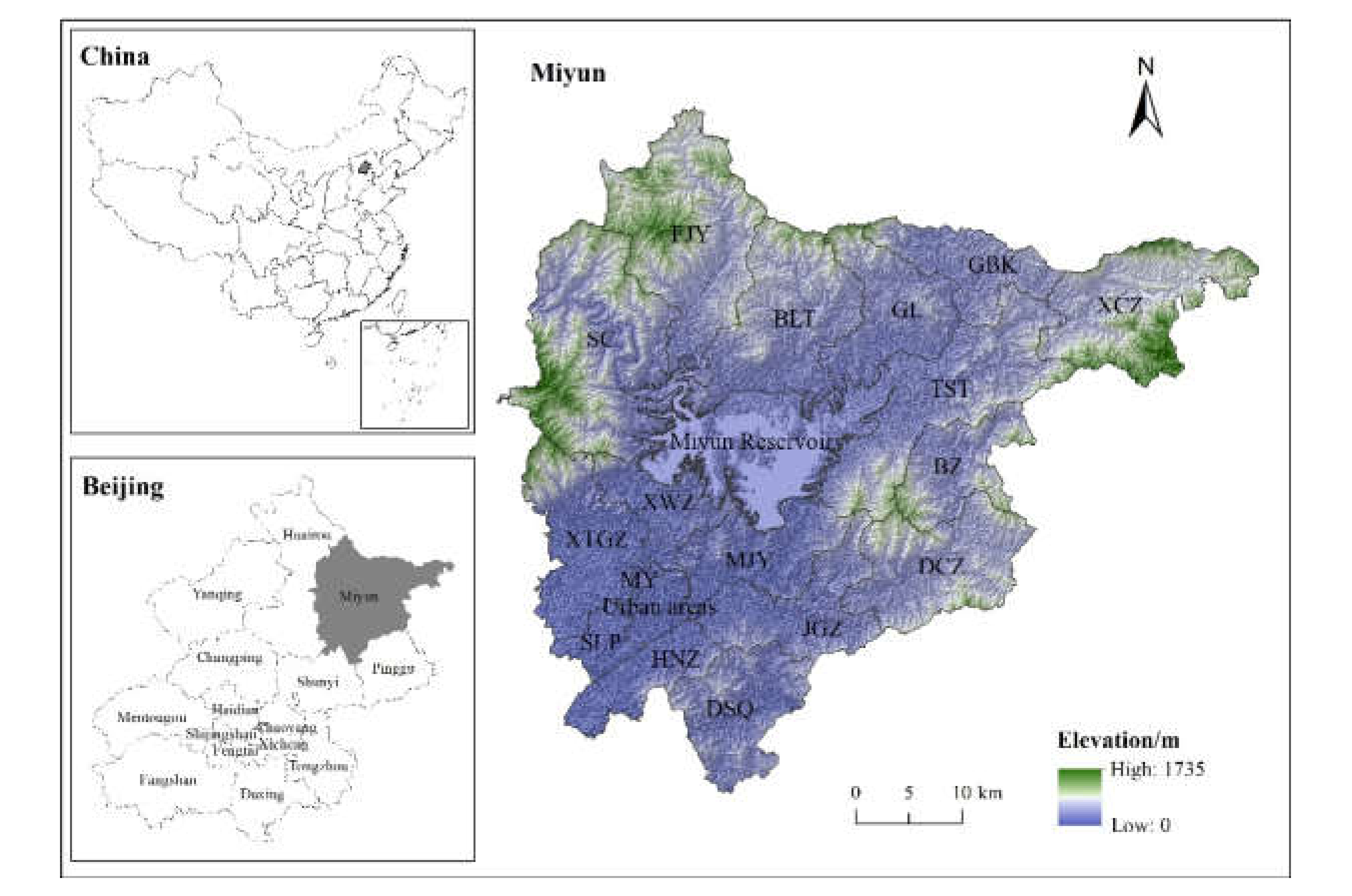
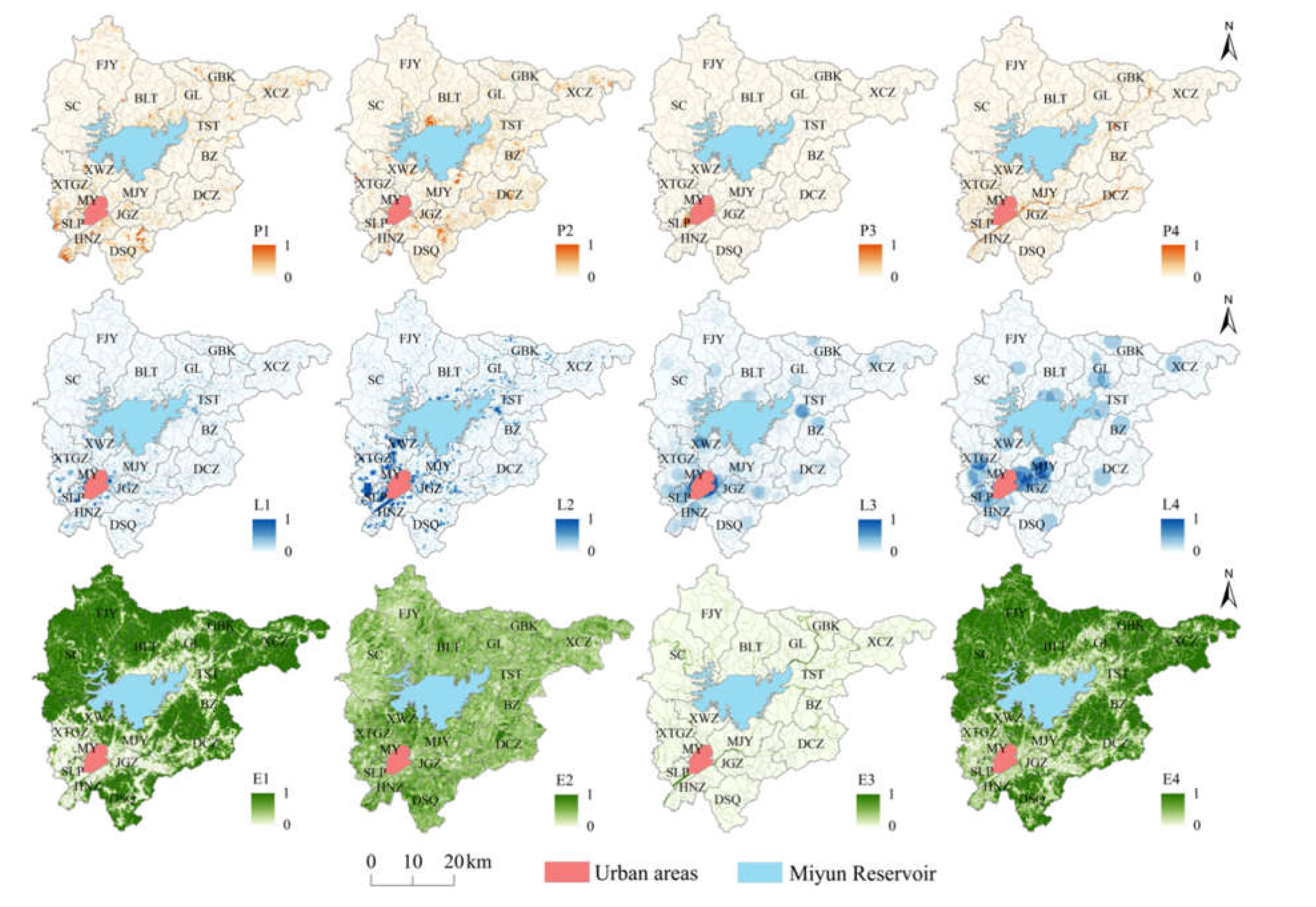
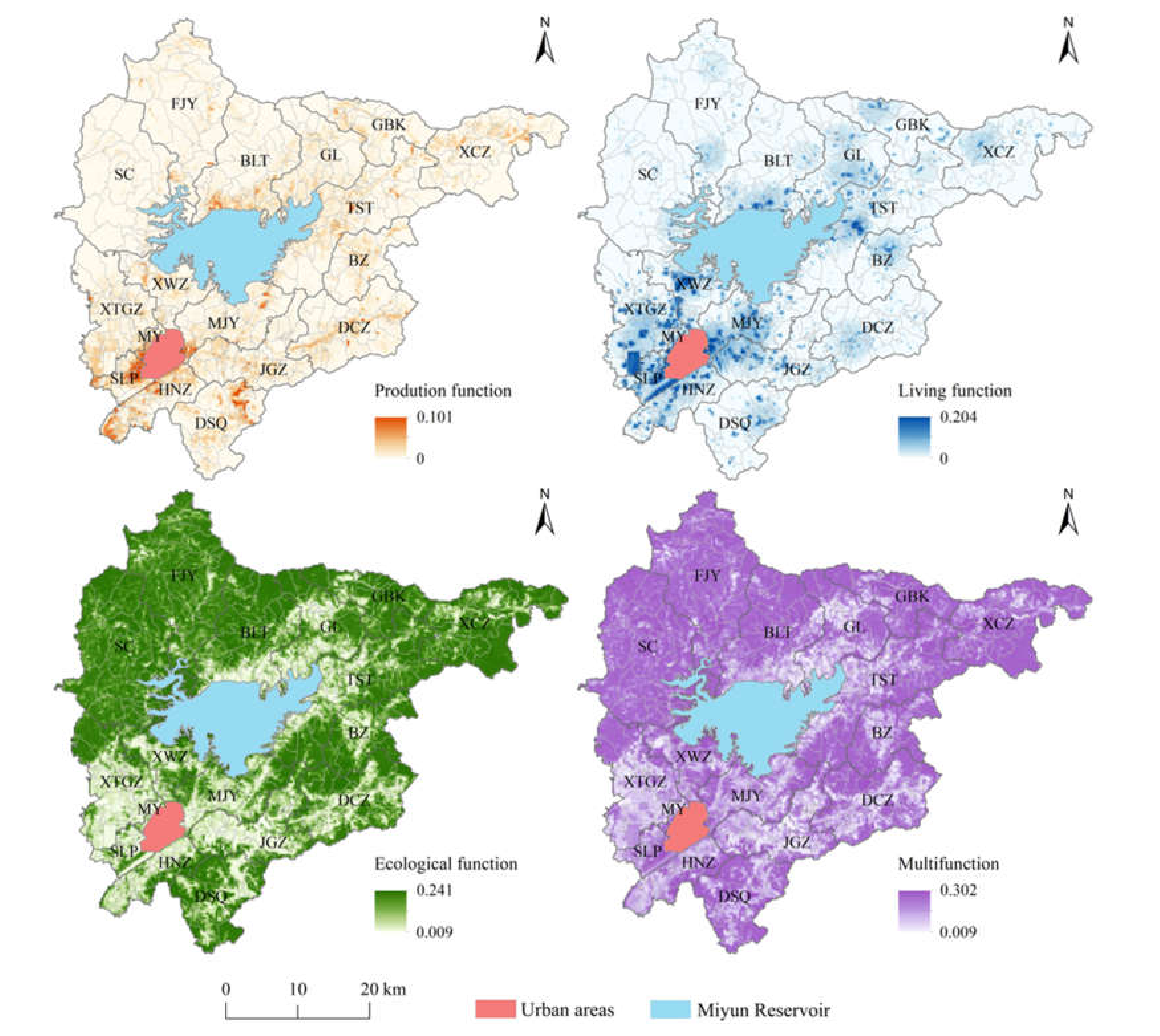
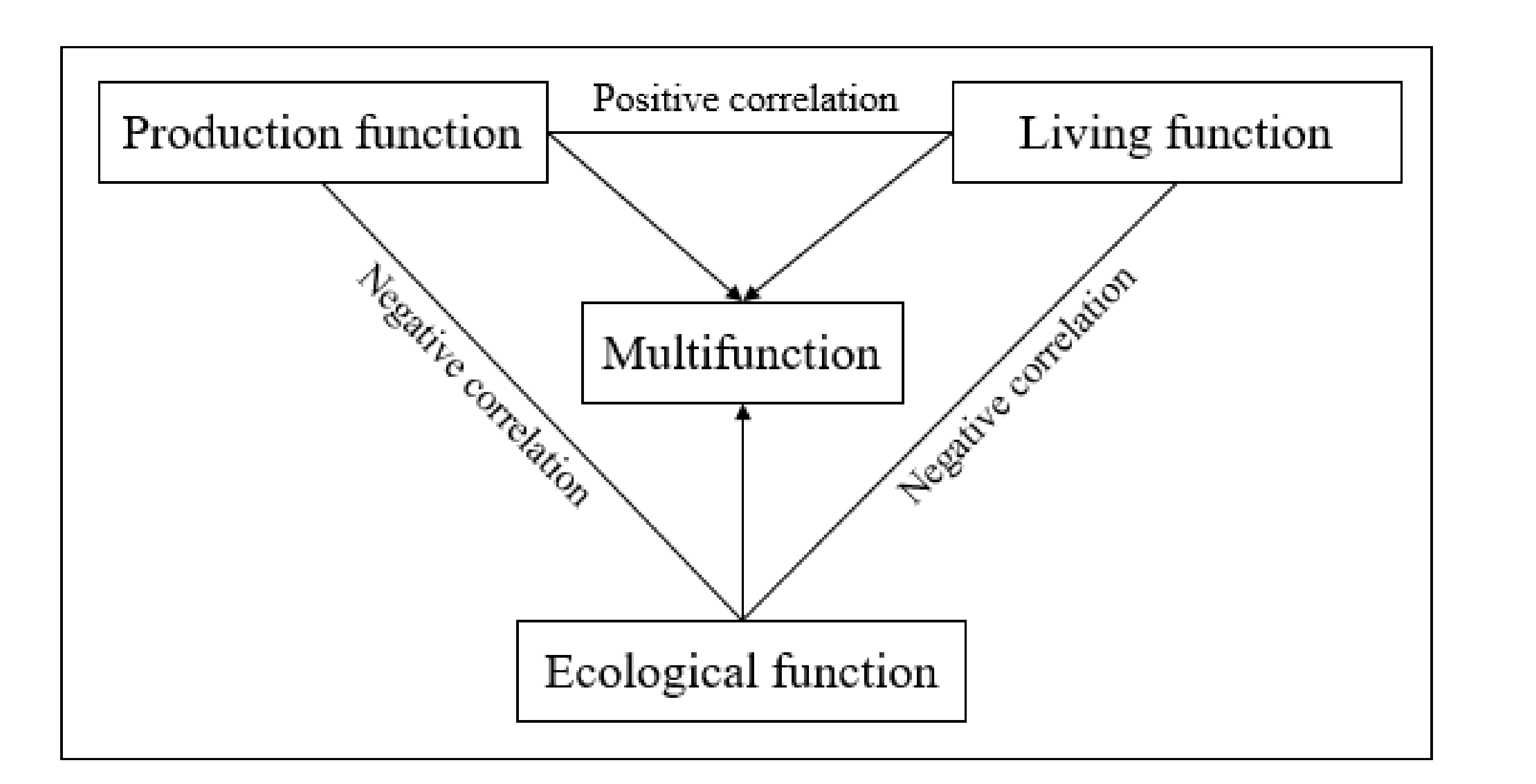
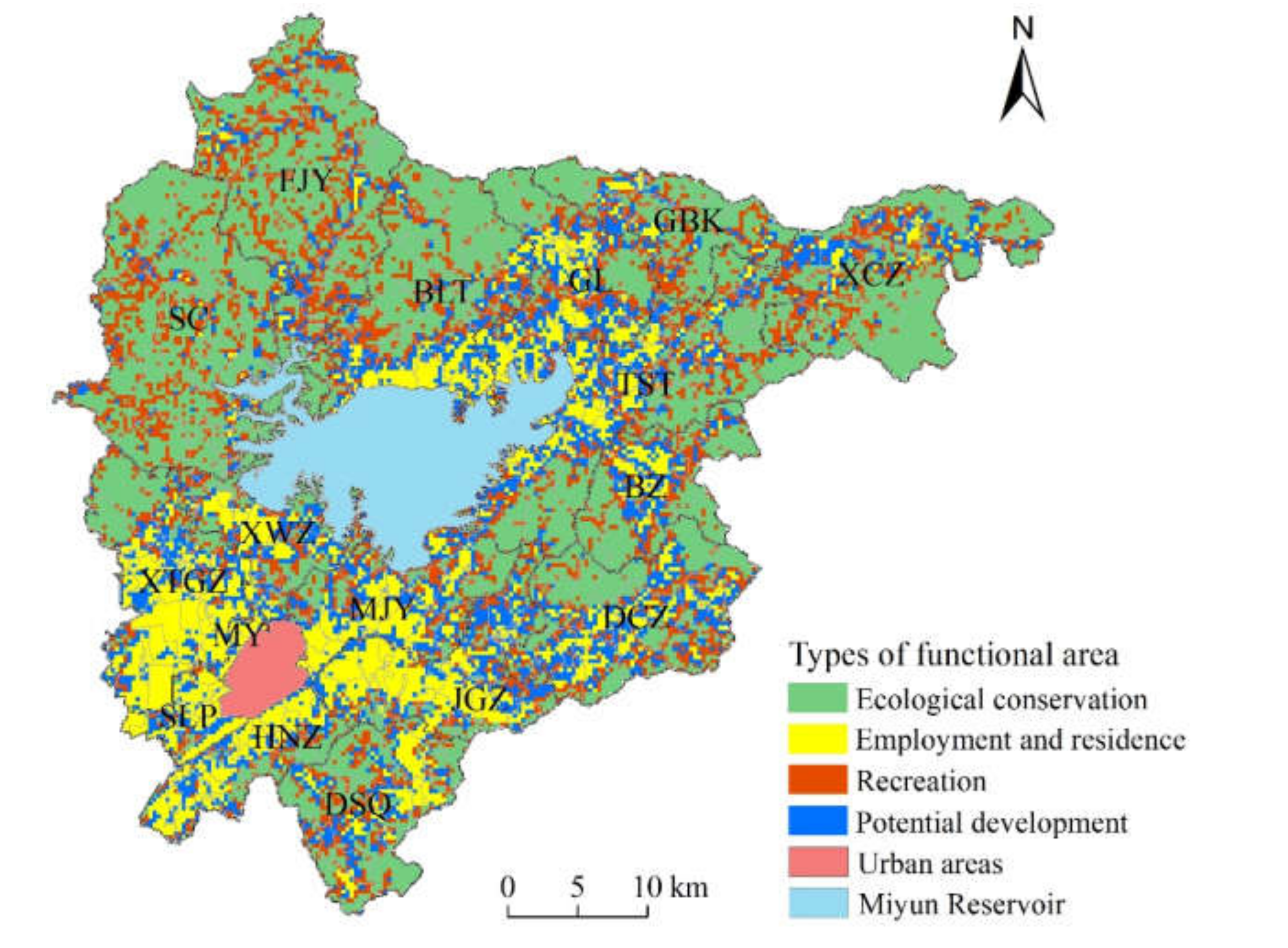
| Criteria | First Level Indicators | Basic Level Indicator | Calculation Method | Weight |
|---|---|---|---|---|
| Production function | Agricultural production | Grain output(P1) | Grain output per grid | 0.088 |
| Fruit output(P2) | Fruit output per grid | 0.061 | ||
| Non-agricultural production | Enterprise aggregation(P3) | Aggregation of enterprises in secondary and tertiary industries | 0.094 | |
| Density of traffic land(P4) | Traffic land area/grid area | 0.057 | ||
| Living function | Basic living | Villagers’ income(L1) | Villagers’ income per grid | 0.100 |
| Density of rural settlements(L2) | Rural settlements area/grid area | 0.095 | ||
| Welfare guarantee | Coverage of medical institutions(L3) | Coverage of medical institutions such as hospitals, health centers and clinics | 0.054 | |
| Coverage of primary and secondary education(L4) | Coverage of primary and secondary schools | 0.051 | ||
| Ecological function | Ecological conservation | Forest coverage rate(E1) | Forest area/grid area | 0.121 |
| NDVI(E2) | Normalized difference vegetation index | 0.056 | ||
| Ecological maintenance | Water and wetland coverage rate(E3) | Water and wetland area/grid area | 0.156 | |
| BRI(E4) | Biological richness index | 0.067 |
| Minimum Value | Average Value | Maximum Value | |
|---|---|---|---|
| Production function | 0 | 0.002 | 0.101 |
| Living function | 0 | 0.012 | 0.204 |
| Ecological function | 0.009 | 0.190 | 0.241 |
| Multifunction | 0.009 | 0.203 | 0.302 |
Publisher’s Note: MDPI stays neutral with regard to jurisdictional claims in published maps and institutional affiliations. |
© 2021 by the authors. Licensee MDPI, Basel, Switzerland. This article is an open access article distributed under the terms and conditions of the Creative Commons Attribution (CC BY) license (https://creativecommons.org/licenses/by/4.0/).
Share and Cite
Yin, Z.; Liu, Y.; Pan, Y. Evaluation and Classification of Rural Multifunction at a Grid Scale: A Case Study of Miyun District, Beijing. Sustainability 2021, 13, 6362. https://doi.org/10.3390/su13116362
Yin Z, Liu Y, Pan Y. Evaluation and Classification of Rural Multifunction at a Grid Scale: A Case Study of Miyun District, Beijing. Sustainability. 2021; 13(11):6362. https://doi.org/10.3390/su13116362
Chicago/Turabian StyleYin, Ziyan, Yu Liu, and Yuchun Pan. 2021. "Evaluation and Classification of Rural Multifunction at a Grid Scale: A Case Study of Miyun District, Beijing" Sustainability 13, no. 11: 6362. https://doi.org/10.3390/su13116362
APA StyleYin, Z., Liu, Y., & Pan, Y. (2021). Evaluation and Classification of Rural Multifunction at a Grid Scale: A Case Study of Miyun District, Beijing. Sustainability, 13(11), 6362. https://doi.org/10.3390/su13116362





